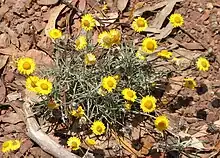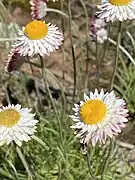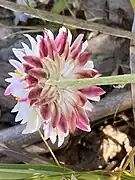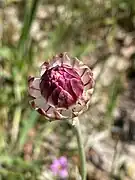Leucochrysum albicans
Leucochrysum albicans, commonly known as hoary sunray,[2] is a flowering plant in the family Asteraceae. It is a small perennial with grey leaves, white or yellow flower-heads and is endemic to Australia.
| Leucochrysum albicans | |
|---|---|
 | |
| Near Licola, Victoria | |
| Scientific classification | |
| Kingdom: | Plantae |
| Clade: | Tracheophytes |
| Clade: | Angiosperms |
| Clade: | Eudicots |
| Clade: | Asterids |
| Order: | Asterales |
| Family: | Asteraceae |
| Genus: | Leucochrysum |
| Species: | L. albicans |
| Binomial name | |
| Leucochrysum albicans | |
| Synonyms[1] | |
| |
Description
Leucochrysum albicans is an upright, tufted perennial to 45 cm (18 in) high. The leaves are linear to oblong or broadly egg-shaped, woolly, 2–10 cm (0.79–3.94 in) long, 1–9 mm (0.039–0.354 in) wide, light grey and crowded near the base of the stems. The flower heads 2–4 cm (0.79–1.57 in) in diameter, borne singly on a slim peduncle 7–15 cm (2.8–5.9 in) long. The outer bracts brown, inner bracts white or yellow in rows, triangular to narrow-elliptic shaped with a woolly lamina at the base. Flowering occurs in spring and summer and the fruit is an achene 3 mm (0.12 in) long and covered with feathery-like white bristles.[3][4][5][6]
Taxonomy and naming
The species was first formally described by botanist Allan Cunningham in 1825 in Geographical Memoirs on New South Wales and gave it the name Helichrysum albicans.[7] In 1992 Paul Graham Wilson changed the name to Leucochrysum albicans in the journal Nuytsia.[8][9]The specific epithet (albicans) means "whitish".[10]
In the same edition of the journal Nuytsia, Wilson described three varieties and two subspecies, albicans and alpinum of L. albicans.[9] In 2010 Neville Grant Walsh transferred von Mueller's Helipterum incanum var. alpinum to Leucochrysum as L. alpinum in the journal Muelleria, including L. leucochrysum subsp. alpinum as a synonym.[11] In a 2015 edition of Muelleria, Walsh raised the rank of de Candolle's Helipterum incanum var. tricolor to subspecies as L. albicans subsp. tricolor.[12]
The names of the two subspecies have been accepted by the Australian Plant Census:
- Leucochrysum albicans (A.Cunn.) Paul G.Wilson subsp. albicans[13] has yellow inner involucral bracts.[14][15]
- Leucochrysum albicans (DC.) N.G.Walsh subsp. tricolor[16] has white inner involucral bracts.[17][18]
Distribution and habitat
Hoary sunray is a widespread species found growing in moist, rocky alpine locations in woodlands and grasslands on nutrient poor soils in New South Wales, Victoria, Queensland and Tasmania.[3][4][5][15] Subspecies tricolor mainly grows in grassland or grassy woodland at altitudes between about 100 and 900 m (330 and 2,950 ft) in disjunct populations in Tasmania, Victoria and south-eastern New South Wales, although it has not been recorded this century in Victoria.[17][18][19][20]
Conservation status
Subspecies tricolor is listed as "endangered" under the Australian Government Environment Protection and Biodiversity Conservation Act 1999,[20] the New South Wales Government Biodiversity Conservation Act 2016[19] and the Victorian Government Flora and Fauna Guarantee Act 1988.[18] A National Recovery Plan has been prepared.[21]
 White form
White form Bracts
Bracts Bud
Bud
References
- "Leucochrysum albicans". Australian Plant Census. Retrieved 13 June 2023.
- "Leucochrysum albicans". Native Plant Profiles. Australian Native Plant Society (Australia). Retrieved 13 June 2023.
- "Leucochrysum albicans (A.Cunn.) Paul G.Wilson". PlantNET - New South Wales Flora Online. Royal Botanic Gardens & Domain Trust, Sydney Australia. Retrieved 21 November 2011.
- Schaumann, M.; Barker, J.; Grieg, J. (1987). Australian Daisies. Sydney: Lothian Publishing. p. 156. ISBN 0850912911.
- Sharp, Sarah; Rehwinkel, Rainer; Mallinson, Dave; Eddy, David (2015). Woodland Flora a Field Guide for the Southern Tableland (NSW & ACT). Canberra: Horizons Print Management. ISBN 9780994495808.
- Short, Philip S.; Walsh, Neville G. "Leucochrysum albicans". Royal Botanic Gardens Victoria. Retrieved 18 June 2023.
- "Helichrysum albicans". Australian Plant Name Index. Retrieved 14 June 2023.
- "Leucochrysum albicans". Australian Plant Name Index. Retrieved 14 June 2023.
- Wilson, Paul (1992). "Leucochrysum albicans". Nuytsia. 8 (3): 442. Retrieved 14 June 2023.
- George, A.S; Sharr, F.A (2021). Western Australian Plant Names and their meanings (4th ed.). Kardinya: Four Gables. p. 131. ISBN 9780958034197.
- Dennis, R.J.; Walsh, Neville G. (2010). "A revision of the Leucochrysum albicans (Asteraceae: Gnaphalieae) complex". Muelleria. 28 (2): 133–134. Retrieved 17 June 2023.
- Walsh, Neville G. (2015). "Elevation of rank for Leucochrysum albicans var. tricolor (Asteraceae: Gnaphalieae)". Muelleria. 34: 13. Retrieved 17 June 2023.
- "Leucochrysum albicans subsp. albicans". Australian Plant Census. Retrieved 13 June 2023.
- Wilson, Paul G. "Leucochrysum albicans var. albicans". Royal Botanic Garden Sydney. Retrieved 17 June 2023.
- Short, Philip S. "Leucochrysum albicans subsp. albicans". Royal Botanic Gardens Victoria. Retrieved 18 June 2023.
- "Leucochrysum albicans subsp. tricolor". Australian Plant Census. Retrieved 13 June 2023.
- Wilson, Paul G. "Leucochrysum albicans var. tricolor". Royal Botanic Garden Sydney. Retrieved 17 June 2023.
- Short, Philip S.; Walsh, Neville G. "Leucochrysum albicans subsp. tricolor". Royal Botanic Gardens Victoria. Retrieved 18 June 2023.
- "Hoary Sunray - profile". New South Wales Government Office of Environment and Heritage. Retrieved 17 June 2023.
- "SPRAT Profile Leucochrysum albicans subsp. tricolor". Australian Government Department of Climate Change, Energy, the Environment and Water. Retrieved 17 June 2023.
- Sinclair, Steve J. "National Recovery Plan for the Hoary Sunray Leucochrysum albicans var. tricolor" (PDF). Australian Government Department of Climate Change, Energy, the Environment and Water. Retrieved 18 June 2023.
